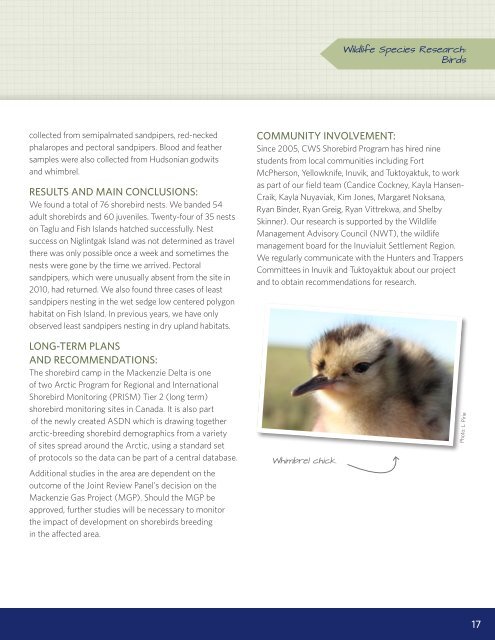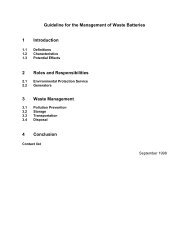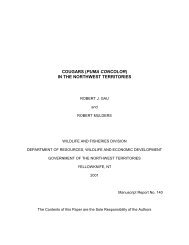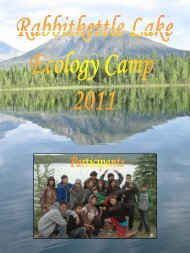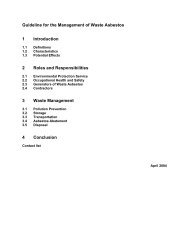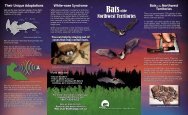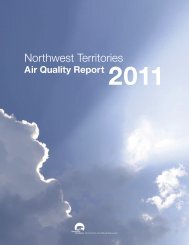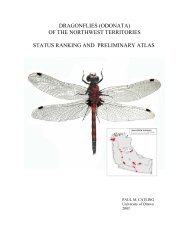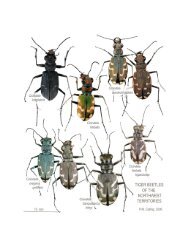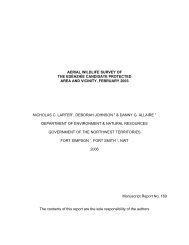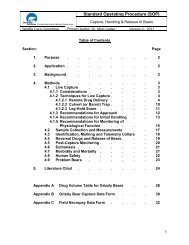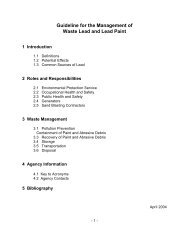2011 Annual Report of NWT Wildlife Research Permits and Western ...
2011 Annual Report of NWT Wildlife Research Permits and Western ...
2011 Annual Report of NWT Wildlife Research Permits and Western ...
You also want an ePaper? Increase the reach of your titles
YUMPU automatically turns print PDFs into web optimized ePapers that Google loves.
<strong>Wildlife</strong> Species <strong>Research</strong>:<br />
Birds<br />
collected from semipalmated s<strong>and</strong>pipers, red-necked<br />
phalaropes <strong>and</strong> pectoral s<strong>and</strong>pipers. Blood <strong>and</strong> feather<br />
samples were also collected from Hudsonian godwits<br />
<strong>and</strong> whimbrel.<br />
RESULTS AND MAIN CONCLUSIONS:<br />
We found a total <strong>of</strong> 76 shorebird nests. We b<strong>and</strong>ed 54<br />
adult shorebirds <strong>and</strong> 60 juveniles. Twenty-four <strong>of</strong> 35 nests<br />
on Taglu <strong>and</strong> Fish Isl<strong>and</strong>s hatched successfully. Nest<br />
success on Niglintgak Isl<strong>and</strong> was not determined as travel<br />
there was only possible once a week <strong>and</strong> sometimes the<br />
nests were gone by the time we arrived. Pectoral<br />
s<strong>and</strong>pipers, which were unusually absent from the site in<br />
2010, had returned. We also found three cases <strong>of</strong> least<br />
s<strong>and</strong>pipers nesting in the wet sedge low centered polygon<br />
habitat on Fish Isl<strong>and</strong>. In previous years, we have only<br />
observed least s<strong>and</strong>pipers nesting in dry upl<strong>and</strong> habitats.<br />
COMMUNITY INVOLVEMENT:<br />
Since 2005, CWS Shorebird Program has hired nine<br />
students from local communities including Fort<br />
McPherson, Yellowknife, Inuvik, <strong>and</strong> Tuktoyaktuk, to work<br />
as part <strong>of</strong> our field team (C<strong>and</strong>ice Cockney, Kayla Hansen-<br />
Craik, Kayla Nuyaviak, Kim Jones, Margaret Noksana,<br />
Ryan Binder, Ryan Greig, Ryan Vittrekwa, <strong>and</strong> Shelby<br />
Skinner). Our research is supported by the <strong>Wildlife</strong><br />
Management Advisory Council (<strong>NWT</strong>), the wildlife<br />
management board for the Inuvialuit Settlement Region.<br />
We regularly communicate with the Hunters <strong>and</strong> Trappers<br />
Committees in Inuvik <strong>and</strong> Tuktoyaktuk about our project<br />
<strong>and</strong> to obtain recommendations for research.<br />
LONG-TERM PLANS .<br />
AND RECOMMENDATIONS:<br />
The shorebird camp in the Mackenzie Delta is one<br />
<strong>of</strong> two Arctic Program for Regional <strong>and</strong> International<br />
Shorebird Monitoring (PRISM) Tier 2 (long term)<br />
shorebird monitoring sites in Canada. It is also part<br />
<strong>of</strong> the newly created ASDN which is drawing together<br />
arctic-breeding shorebird demographics from a variety<br />
<strong>of</strong> sites spread around the Arctic, using a st<strong>and</strong>ard set<br />
<strong>of</strong> protocols so the data can be part <strong>of</strong> a central database.<br />
Additional studies in the area are dependent on the<br />
outcome <strong>of</strong> the Joint Review Panel’s decision on the<br />
Mackenzie Gas Project (MGP). Should the MGP be<br />
approved, further studies will be necessary to monitor<br />
the impact <strong>of</strong> development on shorebirds breeding<br />
in the affected area.<br />
Whimbrel chick.<br />
Photo: L. Pirie<br />
17


